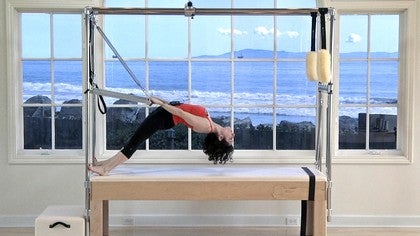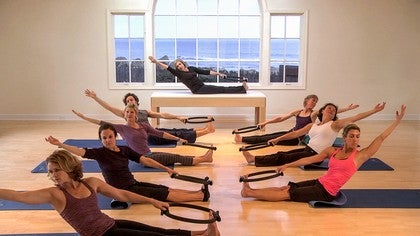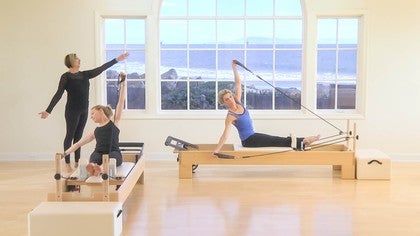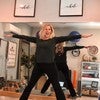Description
About This Video
Transcript
Read Full Transcript
Hello, I'm Rebecca Rotstein. I'm happy to be back here at [inaudible] anytime and today we are going to be doing a Cadillac class and we're going to be bringing in some different spiral patterns as well. Putting a little bit of a twist, no pun intended, on some classical moves on the Cadillac and we're going to be integrating some PNF patterns as well as some different stretches and releases. So we're going to begin here with what is probably my all time favorite stretch. I call this the rack. Some people have called this Rebecca's rack in classes or at workshops I've taught.
So you're going to begin with one hand on the push through bar and the other hand on the roll down bar and you're going to sit down, you're going to push the push through bar down. So we're seated almost in a mermaid position. And then we're going to side bend over. Take a nice breath in and exhale. So the purpose of this is I'm getting a significant stretch on my neck muscles on this side that I'm moving right here and I could even let my head go further for additional scalene or neck stretch, but it's also through the Fascia, through the connective tissue that at this point here I really feel stretching through my arm and I'm going to allow the bar to rise and I'm going to pull the bar down and stretch once again.
And if you want you could rotate and extend that back knee so that you feel the stretch again and let the bar rise. And now take that hand from the push through bar and side bend over to grab hold of the roll down bar. And then I'm going to pull just a little bit. So I'm activating through the side, holding it for several seconds before I release and it's a really, really wonderful stretch to her, that lateral line of Fascia, especially if you have any tightness through the back or the side. And once again pull and hold it and I'll release and then I'm going to move my elbow so that it moves in front of my face and I'm going to side bend over and get additional stretch. The thing I love about this right here is a release along the spine, so any kind of tightness that might be pulling, especially on the rom voids and coming up.
Now we're going to turn around and try the other side so we don't even have to remove her hand. We're going to pull the bar down when you take a breath in and I'm going to side bend over and because of my body right now I feel quite a bit of stretch also still on the right side, so it's very informative. That's the interesting thing. It tells you where there might be some restrictions in your body and on this point because of a little bit more tightness in my right hip, the pressure of the push through bar here, grounds my opposing hip, my right hip here and gives me a little bit more weight and helps me get a little bit more of a glide posteriorly into the socket, which feels really wonderful. And now I'm going to let the bar rise. I'm going to pull the bar down again and I'm going to stretch over. Take a breath in and exhale and return.
Letting that push through bar rise. I'm going to reach over and grab hold of the roll down bar and now I'm going to pull just a little bit, give a little bit of tension going a bit through the laps as well and release to stretch further and I'm going to pull and then I'm going to release and stretch. Now I lower my elbow in front of me and I side bend the other direction. And you'll notice it's not that it's so much of a side bend, it's more you can see as I point here, that that connected tissue and the musculature is being pulled away from my spine, giving me a great release and rise. The next stretch that I'd like to do at the beginning here, again, because I believe very much that we often have to release the tight and restricted areas before we can ask the other areas to engage is for the adductors, for the inner thighs. It's going to move my mic here for a second.
So we're seated, straddling the push or a straddling the Cadillac for a push through. So I'm pushing the bar down and I feel an intense stretch through my groin here as I push the bar forward and then I return and I let the bar rise and I push my hands straight forward into the bar and pull the bar down and stretch forward.
And last time a little postier tilt as we rock that pelvis back, getting a little abdominal engagement as we rise. So let's turn around and let's go to the roll down bar here. So I have the roll down bar about oh maybe almost a quarter of the way from the top in its setting. So we're going to inhale, I don't want you to press down through the shoulders. I want to be very clear about that. I want the shoulders to be heavy. So take your shoulders out of your pockets and now roll down.
And notice I'm not doing that much of an articulation through my spine. Let's just do three poles, one, two, three. I'm willing to drop the Chin and start rolling up. Inhale here and exhale. So I'm minimizing the curve in my spine so that I can maintain it rather equal distant throughout each of the curves. Two, three drop the chin, hollowing out that low belly to rise.
Inhale here and exhale. So notice that it's the wheels of my pelvis rolling back, which initiates the movement and all the way down to one, two, three, and slowly rising up. So we're going to pick up the pace a little bit. We're going to pull back with one elbow until it touches the math and return up and the other one return up. So we're alternating sides. Let's exhale and exhale and exhale, and once more and last time.
Now let's pull one elbow down and stay there in that hinged back position to get to the other elbow and rise. So we go left elbow, right elbow rise, right, left, rise left, right. RA's were lifted through the belly the whole time though. Protecting our back. And last time feeling a little bit of a bleak here and release. Now place one hand in the center of the bar. Place the other hand around your belly and lower yourself down.
Just a small pelvic tilt and rise up. So notice that without the other hand here, there's a tendency to rotate away. So we're going to avoid that tendency to rotate and stay nice and square. Getting some external oblique action on that side, connecting into your internal bleaks on the other side and once more and rising up on this last one, let's do a little stretch. So we're going to side bend over and reach that foot to the other bar so that you can feel quite a bit of stretch here perhaps to the it band and through the side above it and move that, that foot, sliding it out and rise up. Switch hands.
Inhale here. See how tall you could grow. Exhale, notice that it's not a collapse, but it's a little tilt to the pelvis in order to lower down. I want to be very clear about that and returning back up. So whenever we're articulating their still length, there was never a collapse and lowering down and returning up and once more and returning up. And on this last one we'll get our nice juicy stretch. So we'll lower down and circle the arm around to the side of the Cadillac and then slide that foot in and savor this moment of the stretch. Take a breath in and exhale, pushing out through both feet, returning the foot to the bar and rising up.
So let's release the bar here, the roll down bar. And let's now move to the other side. We're going to do a little bit with our push through bar, placing your hands on the bar, having it just a little bit in front of your shoulders. I want you to see how the bar can rise. And now keeping your elbow straight. Pull the bar down.
So you're going to find a little bit of a connection into your shoulder sockets. And I'd like you know to do just a couple of knee drops. So we're going to initiate with the feet, bringing in a little bit of some Bertini of here. The knees fall to the right and then they return to center initiating with the feet, the knees fall to the left and return to center and to the right and return to center and once more to the left, return to center. And let's pull the bar in as we fall and return up and pull the bar in as we fall. And turn up. Now let's try the opposite way.
So let the knees fall to the right and pull the bar in. Let the knees fall to the left. Pull the bar in. Once more than knees fall, we pull the bar, the knees fall, we pull the bar. And we're going to return to this shortly. But first we're gonna review some teaser. So let's push the bar behind us.
Inhale here. Elevate your shoulders. Let the bar pull you, and now release the shoulders, spreading your collarbones and return the bar. Drop the Chin in order to tease her up. Inhale here and exhale, lowering back down. Push the bar back. Inhale here, and exhale returning. Let's extend one knee.
Let's now extend the other knee and let's do three poles. One, two, three. Bend the knees, rock the wheels of your pelvis to initiate the lowering down. Push the bar behind you. Inhale, exhale. Extend the knees. This time, dropping the chin, reaching your toes out in front of you for them to arch up. Three poles with the bar. One, two, three, lowering the feet as we lower chest. Push the bar behind you. Inhale and exhale, returning forward, lengthen out through the toes so that we don't experience a gripping in our hip flexors. Let's lower one foot down and back up.
Let's lower the other foot down and back up, right foot, down and up and left foot down and up. And let's lower the feet as we lower our chest. Finding that what I referred to as the zip up has the core of powerhouse engagement to protect our spines. Let the bar return in. And now this time, let's bend our knees and do a little knee drop to the right and lower yourself down. Pulling the bar behind you and returning the bar forward. Knee drop to the left in our little teaser.
And now let's speed that up. So we're going to lift with the knee drop, we're going to lower lift with the knee drop lower. Keep going.
We want the tension to be in the front of the neck as opposed to in the back of the neck and relax the feet down. Push the bar behind you, breathe in, and exhale. Let the bar rides once more. Coming back up into neutral. Inhale here and exhale, articulating through the spine. Push the bar behind you. We're now going to bring in a little bit more of our interesting PNF pattern with some complicated spirals that are not so complicated. So bear with me. You may have to watch this a couple times, but it's going to be fun. It's going to feel great in your body.
So I'd like you to take your arms or actually keep your hands here, but let your knees fall to the side. Now, whichever is the side that they have fallen to. So for instance, our right side, that's the hand that will remain on the bar. So I'm going to pull the bar in here and just get myself back just a little bit so that it feels a little bit more comfortable on the shoulder. It should not feel uncomfortable. And now as the bar rises, I'm simply rolling to the other side. And for this it's a knee drop, but it's also allowing my whole torso to twist. So it's very simple. I roll to one side and the bark lowers, I roll to the other side and the bar rises. We're going to build on this. Now I roll to the right and I pull the bar in.
As I roll to their side, I prop myself up on my elbow and I roll down. So this is part of a very natural movement pattern here. And without thinking you're going to get that automatic core engagement. You're also going to get some of the deep neck strengthening without having to actively think about it. Let's extend that top knee as we rise. Make it a little bit harder.
Extend the top knee as you rise once more, extend the top knee and extend the top knee. And now at this point, let's stay here. So you're propped up on your elbow and we're already in a shortened position for hip abduction. And so we're going to continue with that. Lifting up. One, two, three, four, five and roll in and roll away. Go Up. One, two, three, four, five. Roll in, roll away. Lift up. One, two, three, four, five. To make it even more challenging. You could do it without the arm support and lower in and last time.
Roll away and go. One, two, three, four, five. See if you could let go of the bar holding. Looking up at your hand here and we're going to now lower ourselves onto our left side. So the same principle is what we were doing before the left hand is on the bar because we're rolled onto our left side and I'm moving myself just to make it comfortable for my shoulder so that my hands shouldn't, as I'm calling in, my hand should be below my shoulder in this direction. So I'm just going to start with the rolling side to side, making sure that I have enough space so that I don't fall off the Cadillac and rolling away. So again, as I roll away, the bar rises and I roll in and the bar comes in, I roll away and the bar rises. We're going to make it more complicated. We pull in, as the bar lowers here, making it more complicated.
We rise up onto that elbow and we lower rolling in. We rise. Rolling up. We lower rolling in. So at this point here, this is where my neck muscles start to work. This is really important for anytime you're doing any classical or traditional palladia where you lift your head off the mat, it's what's going to help you avoid that strain in your neck and rise up. And last one. And we rise up.
And at this point here, let's do our three lifts. One, two, three, rolling in and rolling away. Look at it. One, two, three. I'm staying lifted in the belly. Rolling in, rolling away. And one, two, three, rolling in. And let's do one last time and one, two, three. And now let stay here. Remove the hand, hold it and relax yourself down. So you should feel a little bit of work going on through the whole midsection. At this point, let's roll onto our stomachs and we're now going to bring in a little bit of back work. So for Swan, I would like us all to have our hands on the bar. With our elbows straight and the bar, we'll just barely be crossing the vertical frame.
So to begin with making sure that your fingers are firmly wrapped or your thumbs are firmly wrapped around the bar, I want you to press your hands down to the bar. Notice the shoulder activation that occurs. Also ground your pubic bone to protect your back so that you don't arch the back like this. So I've grounded the pubic bone, I'm pressing my hands down into the bar and then I just float my head off the mat and I lower back down. And once again, press your hands into the bar, float your head off the mat and you can come a little bit higher if it's comfortable and lower back down. And last time press your hands down into the Bart.
Inhale to rise and exhale to lower. Now let's the, let's allow the bar to assist us. This is one of the most interesting parts of the Swan, I find because the elbows are going to bend. We're now pushing our hands forward into the bar and that's what helps us rise so that we lengthen and reach our fingers all the way up to the ceiling. And then we lower ourselves down and extend the bar straight in front.
Inhale here, allowing the shoulders to release and exhale, letting the bar return in. Bart assists us in rising. Again, notice that the direction of force is straight into the bar, so I'm not having to push the bar up. I'm using the bar for assistance in hill and I lift up through the belly to protect my back and I do squeeze my butt a little bit to protect my back and I start to lower down lifting through the belly. Continuing one last time. Breathe in, allowing that release in the shoulders to occur and exhale. Inhale, push it up a little higher this time and pulling the bar down. Now I want you to Tuck your pelvis for a moment and now release it and now it ground that pubic bone and I want you to push your hands for a while.
You extend out through your feet. So we're going to arc up through our feet and lower them down and alternately rise up through the chest and lower down. So we arch out through the feet. This avoids any compression in the low back and we rise up and let's speed it up a little bit more of a traditional swan. Inhale and exhale and inhale.
Feel it in the glutes. Inhale last time. Exhale, inhale and lower yourself down. So safely return the bar up to where it was previously. And let's go onto our backs. Once more, pull your knees to your chest here. And I'd like you to do a couple bridges, but before we begin our bridges, make sure that your feet are aligned so that your feet are hip distance apart. So you're going to bridge up here leading with the pelvis and lowering down.
Push your feet down into the ground and lower back down. And last time bridge up here. Lift your hands up to the ceiling.
And let's add in a little bit of coordination, crossing the arms while we hold this position. One, two, three, four, five, both arms up overhead. Reach your hands overhead as if you're still pushing the bar there and articulate through the spine to lower down. Arch your back and now flatten it once more arch and Laura the hands to flatten. Let's sit up and I'm going to face away from you. At this point we're going to do a little mermaid stretch.
So for our mermaid I'd like you to push the bar down. I want you to side bend over and rise up. And once again, side bend over and rise up. Now side bend over, reach out through the hand, extending out through that same side knee and lengthen out. So you're going to feel it again in the glute and returning and I want you to swing your feet around to the other side, letting the bar rise, breathe in.
Exhale, pull the bar down, send it straight out and side bend over. So I'm not doing that much of a side bend because it also depends on the stability of your shoulder. And now returning and let the bar rise and pull the bar down and side bend over and now rotate. So it's good. Feel very nice. Stretch on the back. Extend that side knee as the hand that just touched the bar and lengthen forward. And now rise. We positioning the hand if need be and sit up and we let the bar rise.
So now we're going to swing our feet around again. So you're going to lengthen out, push the bar up, reach out through your fingers and swing the feet. So now this transition becomes an exercise unto itself. Lengthen out and swing out and swing out. So we'll have a little fun here. Swing out, swing out, get your heart rate going, swing out last time.
Swing out and relax. And now we're going to do some legwork. So I'm going to lower this bar the crossbar bit because otherwise my legs are going to be killing me and killing you. All right, so I have it probably be about halfway down and I'm going to remove the roll down bar as well. So we're going to lie on our backs to do a little bit of leg spring work, attaching one spring at a time.
We're going to start off with some traditional stuff and then we're going to add some of our interesting twist to this. I personally love to hold my hands here on the vertical bars. I know that many people don't. You're welcome to do either, but if you haven't done this I I challenge you to explore it. So pushing your hands into the bar will help set your Scapula, which is part of the reason I love doing this. So I'm going to start up pushing out in the first position and now I'm going to go into parallel.
So we're just going to do leg arcs rising up and lowering down and rising up and lowering down. Let's do a couple more and if you are exhaling as you lower, see what it would be like to inhale. So mix it up a little bit, get yourself out of your traditional routine and just explore what happens in your body. And now let's go out into some circles. So I'm trying to stay relatively level in my pelvis, trying to prevent that excess motion from occurring. It's just to do two more here and one and now let's reverse her circles and I'm trying to still reach through the crown of my head, finding length through my entire spine. Let's just do one more here and let's bend the knees in for some frog.
We're going to push out and in and out an n just to do two more gluing our heels together. I'm like, I just did in last one. Now let's go into the stagger the Peter Pan. So one knee continues to bend in, the frog likely did. The other goes out to the side and then they meet in the middle. So I bend one knee while the other goes out to the side, and then they meet in the middle. And let's push be sure that you're still breathing.
Push and push and push. And we can imagine that we're still in never, Neverland. And last one, relax. Bend your knees in. Now let's do a little dolphin action, or we could call it the fish tail, but I'm referring to this motion where you arch down, bend the knees and feeling the inner thighs and extend the feet up. And let's do just do five of them. Five and four and three and two should feel this, the inner thighs and her hamstrings. And last one. Now we're going to add in an interesting PNF pattern.
You're going to be in a frog position. You're going to push your feet out. So you're extended in a frog. We're going to internally rotate as we separate our feet and lower down. We're going to externally rotate as we rise up. So we're creating a shape with our legs leading with the heels down and then leading with the heels up, leading with the heels down, leading with the heels up. Two more leading with the heels down, leading with the heels up last time, leading with the heels down, leading with the heels up. Bend your knees, give your calves and your hamstrings a rest for a moment.
Now extend your knees again. This time lowering your feet down. So here we're in a frog position. We're now going to create a v shape with our legs. Again, leading with the heels up, leading with the heels as we lower back down so our feet separate and the heels lead the way to rise, our feet approximate and our heels lead the way to lower. Keep going up, lowering down, up, lowering down to more up lowering down. And you should probably feel a little bit of the burning by now and lowering down and bend your knees and rest for a moment.
So let's do a couple of bicycles in each direction. So that PNF set that we just did, that patterning is really wonderful for opening the hips and getting more mobility in the hips. And now let's reverse and it can also be really, really helpful for low back issues and release. Lifting the feet up, bend the knees, grab hold of your straps and separate your feet for a little stretch here. Bend your knees and try and push your feet into straps. See if you feel that additional stretch, perhaps deepen the hip capsule and straighten and once more bend giving some resistance.
So there's nothing passive about this motion and straighten and release your feet. We're going to return and stand up here for a moment. We're going to return to our push through bar. So again, I've been using one red spring this whole time. This is a little bit of a twist on a Kathy grant exercise that I had learned. So this is a variation on it.
I'm not in any way claiming to be doing her version. You can have an additional spring on this if you like it. We'll make it a little bit easier for you. So we're going to start here with a push through and I'm going to push the bar forward with straight knees. Now, unlike the way that I had done it previously, and now first let's just do a little articulated return. So I'm keeping the elbows straight and I'm lowering down.
So I'm going to pull the bar down. I'm rocking the pelvis back and I'm pushing forward and I'm not curving my spine too much. You'll notice I'm also flexing my feet, reaching out through my heels, particularly at this point here as I roll back. I don't want to cramp up in my hips. So as I lengthen out through my heels, that's gonna help keep me out of the tightness in the front of the hips. And at this point here, let's pull the bar down. Let's drag the butt in and I have my toes up on the bar and I'm going to bridge up and rise and lower the butt down slowly and let the bar rise and reach forward. And let's try that again.
So I start here with the little push through with straight elbows, then pushing forward and I return rocking the pelvis back, keep leading out with the heels and rising up. And then I start to pull myself in, dragging my my butt toward my heels and I bridge up undulating through my spine rising and slowly lowering control. So let's reverse that. Let's essentially bridge up here. Let's arch back. Squeeze your butt as you can to protect your back and lower yourself down and let the bar rise. And let's just do that part once again.
So we push our feet into the bar, we bridge up. So there's a lot of work for your arms here. You're going to arch back and you're going to bend the knees, Drop Your Chin and let the bar rise. Put your hands straight forward into the bar. Inhale and exhale. And now let's do a little stretch. Let's reach back, hold it, feel the stretch to the side, arch your hand all the way up and lower the hand to the other side. Inhale and Exhale, arc up and once again
And let's do a little bit standing before we end the place. Your hands here on the bar. We're going to practice a little bit with the hips, incorporating some of the other things we've done. So let's extend our left foot out or behind us I should say, and we're going to try and move our head and our foot at the same pace. Lifting through the supporting arch. No, I want you to feel the support through your hip.
It's very important here that our toes are facing directly forward because this is not to be working our rotators and you're going to rise back up and again, lower down. Now take your right hand, which is not really going to be doing that much work. Grab the Cadillac Crossbar here or I should say I'm sorry, the the um, pull bars and lower yourself down and rise up and push down and rise up. So you're just using these bars here just for a little bit of support and last time and up. And now you're going to switch feet. So we're going to extend our right foot behind us and we're going to push it down on the bar. So notice there's a congruency between as I pushed down on the bar, my back foot rises and this is great for strengthening the hips. So again, it's more the right arm that is doing the work and it's sort of a cross body patterning motion.
And now I'm going to reach up for support with his left hand and I'm going to push down and rise up and push down. So another little spiral. And last time, push down and rise up. And I'd like to end here with a little virgin of a spread eagle. So I'm going to have my feet against either side of the frame here and I'm just gonna sit back with straight needs to start and see if you can feel that nice decompression on your spine and bend the knees. And imagine that your Coxix, which is your tailbone, has a very weight on it.
And now imagine that it's a pendulum and you can let it swing to side to side. And now extend the knees and articulate up through your spine and arch back and growing taller. You can even pull yourself in and send your butt back and bend the knees and straighten the knees. Articulate to rise and opposite into extension and help yourself rise. Pulling in with your biceps and last time, send the butt back, bend the knees. And again, notice if there's a difference in ability to flex it, either one of the two hips. Just observe it. Don't try to change it, just note it and extend the knees. Push the butt back and rise up. And last glorious, juicy extension and help yourself rise.
So I hope that you've enjoyed our Cadillac class, bringing in a couple of different twists literally, as well as metaphorically, and that you will continue to explore movement options that are available on this great machine. Thank you so much.
Anything Goes: Exploring Spirals
Comments
FUN, FUN, FUN!
love this class, just want to do it again and again ...
Thanks for a great session!
You need to be a subscriber to post a comment.
Please Log In or Create an Account to start your free trial.

















